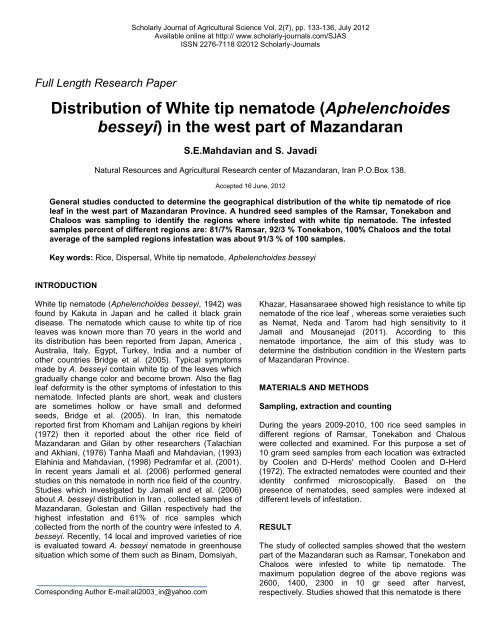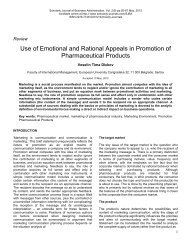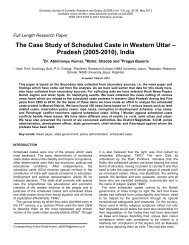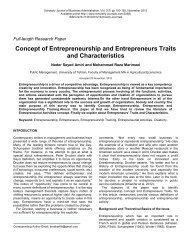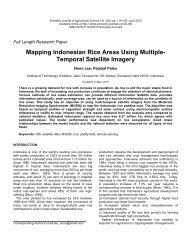Full Article - PDF - Scholarly Journals
Full Article - PDF - Scholarly Journals
Full Article - PDF - Scholarly Journals
Create successful ePaper yourself
Turn your PDF publications into a flip-book with our unique Google optimized e-Paper software.
<strong>Scholarly</strong> Journal of Agricultural Science Vol. 2(7), pp. 133-136, July 2012<br />
Available online at http:// www.scholarly-journals.com/SJAS<br />
ISSN 2276-7118 ©2012 <strong>Scholarly</strong>-<strong>Journals</strong><br />
<strong>Full</strong> Length Research Paper<br />
Distribution of White tip nematode (Aphelenchoides<br />
besseyi) in the west part of Mazandaran<br />
S.E.Mahdavian and S. Javadi<br />
Natural Resources and Agricultural Research center of Mazandaran, Iran P.O.Box 138.<br />
Accepted 16 June, 2012<br />
General studies conducted to determine the geographical distribution of the white tip nematode of rice<br />
leaf in the west part of Mazandaran Province. A hundred seed samples of the Ramsar, Tonekabon and<br />
Chaloos was sampling to identify the regions where infested with white tip nematode. The infested<br />
samples percent of different regions are: 81/7% Ramsar, 92/3 % Tonekabon, 100% Chaloos and the total<br />
average of the sampled regions infestation was about 91/3 % of 100 samples.<br />
Key words: Rice, Dispersal, White tip nematode, Aphelenchoides besseyi<br />
INTRODUCTION<br />
White tip nematode (Aphelenchoides besseyi, 1942) was<br />
found by Kakuta in Japan and he called it black grain<br />
disease. The nematode which cause to white tip of rice<br />
leaves was known more than 70 years in the world and<br />
its distribution has been reported from Japan, America ,<br />
Australia, Italy, Egypt, Turkey, India and a number of<br />
other countries Bridge et al. (2005). Typical symptoms<br />
made by A. besseyi contain white tip of the leaves which<br />
gradually change color and become brown. Also the flag<br />
leaf deformity is the other symptoms of infestation to this<br />
nematode. Infected plants are short, weak and clusters<br />
are sometimes hollow or have small and deformed<br />
seeds, Bridge et al. (2005). In Iran, this nematode<br />
reported first from Khomam and Lahijan regions by kheiri<br />
(1972) then it reported about the other rice field of<br />
Mazandaran and Gilan by other researchers (Talachian<br />
and Akhiani, (1976) Tanha Maafi and Mahdavian, (1993)<br />
Elahinia and Mahdavian, (1998) Pedramfar et al. (2001).<br />
In recent years Jamali et al. (2006) performed general<br />
studies on this nematode in north rice field of the country.<br />
Studies which investigated by Jamali and et al. (2006)<br />
about A. besseyi distribution in Iran , collected samples of<br />
Mazandaran, Golestan and Gillan respectively had the<br />
highest infestation and 61% of rice samples which<br />
collected from the north of the country were infested to A.<br />
besseyi. Recently, 14 local and improved varieties of rice<br />
is evaluated toward A. besseyi nematode in greenhouse<br />
situation which some of them such as Binam, Domsiyah,<br />
Corresponding Author E-mail:ali2003_in@yahoo.com<br />
Khazar, Hasansaraee showed high resistance to white tip<br />
nematode of the rice leaf , whereas some veraieties such<br />
as Nemat, Neda and Tarom had high sensitivity to it<br />
Jamali and Mousanejad (2011). According to this<br />
nematode importance, the aim of this study was to<br />
determine the distribution condition in the Western parts<br />
of Mazandaran Province.<br />
MATERIALS AND METHODS<br />
Sampling, extraction and counting<br />
During the years 2009-2010, 100 rice seed samples in<br />
different regions of Ramsar, Tonekabon and Chalous<br />
were collected and examined. For this purpose a set of<br />
10 gram seed samples from each location was extracted<br />
by Coolen and D-Herds' method Coolen and D-Herd<br />
(1972). The extracted nematodes were counted and their<br />
identity confirmed microscopically. Based on the<br />
presence of nematodes, seed samples were indexed at<br />
different levels of infestation.<br />
RESULT<br />
The study of collected samples showed that the western<br />
part of the Mazandaran such as Ramsar, Tonekabon and<br />
Chaloos were infested to white tip nematode. The<br />
maximum population degree of the above regions was<br />
2600, 1400, 2300 in 10 gr seed after harvest,<br />
respectively. Studies showed that this nematode is there
<strong>Scholarly</strong> J. Agric. Sci. 134<br />
Figure1: The symptomes of white tip nematode (Aphelenchoides besseyi)<br />
Figure 2: Rice cluster with hard infestation to white tip nematode (Aphelenchoides besseyi )<br />
in rice field of the western part of the Mazandaran but<br />
about 8/7% samples didn’t show the infestation. Figure 3<br />
shows the infested samples number which harvested<br />
from west regions of the Mazandaran. As infers from this<br />
Figure, infested samples percent of the western regions<br />
of the Mazandaran to A. besseyi nematode are: 81/7%<br />
Ramsar, 92/3% Tonekaboon and 100% chaloos and<br />
infestation general average of the sampling regions is<br />
91/3% of 100 seed samples.<br />
Disease Symptoms<br />
Nematode symptoms in rice leaves are in form of the tip<br />
of the leaves become white and to turn about 3-5 cm,<br />
finally it will become brown and break (figure1). Delay in<br />
appear of cluster, decrease of seeds and plant growth,
Mahdavian and Javadi 135<br />
120<br />
100<br />
80<br />
Ramsar<br />
60<br />
40<br />
20<br />
0<br />
Number of sample<br />
Number of sample<br />
infection<br />
Percentage of<br />
infection<br />
Tonekabon<br />
Chalos<br />
Figure 3. Percent contamination of rice seed samples in different regien of West parts of Mazandaran<br />
late crops and produce tiller from upper nodes are the<br />
symptoms of the nematode (figure 2).<br />
Disease Factor<br />
Aphelenchoides besseyi nematode is a factor of white tip<br />
of the rice leaf. This nematode belongs to<br />
Aphelenchoididae family.<br />
DISCUSSION<br />
Be extended of A. besseyi distribution regions in rice<br />
fields of the west Mazandaran are due to infested rice<br />
seeds. White tip nematode was seed-borne and it<br />
outspreads by infested seed Ou (1972). High degrees of<br />
infested seeds in thesaurus bed facilities the extent of the<br />
regional infestation Luc and Sikora (1990).<br />
Infestation from soil occurs seldom. Just 5 plants of<br />
2900 plants which produced from healthy seed grow in<br />
infested soil showed disease symptoms, Huang (1959).<br />
Infestation percent will increase when healthy and<br />
unhealthy seeds grow beside each other in a same field.<br />
Irrigation water which use in thesaurus bed contains<br />
nematode and ill membranes, also it cause to facilitate<br />
healthy seeds infestation. All achieved experiments in<br />
Japan show that nematode transfer in field result from<br />
germinated seeds or transplanted seedling Yoshii and<br />
Yamamoto (1950).<br />
According to study the source of the A. besseyi<br />
economic damage threshold including association density<br />
determine in specific number of seed or seed weight.<br />
Fukano (1962) determined the economic damage<br />
threshold of this nematode was 300 fresh nematodes into<br />
100 seeds, although various researchers mentioned<br />
differently, 100 nematodes in 100 seeds or 2-400<br />
nematodes in 100 seeds. Quality number in 1gr seed<br />
(paddy rice) is intermediately 40-45. According to present<br />
study, 20 regions showed the infestation higher than 500<br />
nematodes in 10 gr seed (intermediately, 1/7 nematodes<br />
in each seed). So rice crop damage can be expected by<br />
this infestation amount in above regions. As pointed<br />
before, nematode association in 10 gr seed was more<br />
than 1000 nematodes in 5 regions that is there’s<br />
intermediately 3/6 nematodes in each seeds which<br />
according to economic damage threshold gave by<br />
Fukano (1962) can be injurious. In this study, extracted<br />
nematode association of seeds evaluated less than 100<br />
nematodes in each 10 gr seed in 21 of 100 regions<br />
because probably this amount of nematode association<br />
didn’t have crop damage for farmers. Although some<br />
researchers mentioned 2-400 nematodes in 100 seeds in<br />
economic damage threshold. On the other hand, all<br />
patient plants don’t show the symptoms. Infected plants<br />
may have no symptoms and even decrease can be see<br />
when seeds contain nematode, the characteristic<br />
symptoms of the disease don’t occur. During a study in<br />
Japan, about 75% Infected plants didn’t show symptoms<br />
Yoshii and Yamamoto, (1950). If also pollution amount<br />
was 0.7 %, the economic value of polluted seed will<br />
confront with decrease Inagaki (1985). Study results<br />
show that more resistant plants indicate seldom<br />
symptoms in clusters and leaf, whereas they contained<br />
nematode and also their crops decrease Atkins and<br />
Todd, (1959). More than 50% rice field which infested to<br />
this nematode was reported in Bangladesh. Clusters<br />
weight that were more infested (650 nematodes in 100<br />
seeds) have been a third as compared with plants which<br />
had less infection (112 nematodes in 100 seeds)<br />
Rahman and Taylor, (1983). Nematode association<br />
tolerance estimated 30 live nematodes in 100seeds. This<br />
number cause to 50% damage to crop Fukano (1962).
<strong>Scholarly</strong> J. Agric. Sci. 136<br />
A.besseyi economic damage threshold mentioned 300<br />
live nematodes in 100 seeds and also crop damage has<br />
been reported up to 60% by A. besseyi from different<br />
infected regions of the world Bridge et al. (2005). As<br />
regard to this disease is simply controllable through seed<br />
treatment and by use resist types, such high damage is<br />
rare. Whereas no seed treatment against A. besseyi<br />
factor achieve and also resist types didn’t grow in Iran,<br />
less damage up to relatively high damage can expected<br />
based on study result by effect of nematode.<br />
REFERENCES<br />
Atkins JG, Todd EH(1959).White tip disease of rice. III.Field tests and<br />
variata resistance.Phytopathol., 49:189-191.<br />
Bridge, J, Plowright, RA, Peng, D (2005). Nematode parasites of rice.<br />
In: Luc. M Sikora, RA, and Bridge J. (Eds). Plant parasitic nematodes<br />
in subtropical and tropical agriculture, 2nd Edition. Wallingford, UK,<br />
CAB International Publishing, pp 87-129.<br />
Christie, JR (1942). “A description of Aphelenchoides besseyi n.sp., the<br />
summer-dwarf nematode of strawberries, with copments on the<br />
identidy of Aphelenchoides subtenuis (Cobb, 1929) and<br />
Aphelenchoides hodsoni Goodey, 1935.Proc. helminth. Soc. Wash.<br />
9: 82-84.<br />
Coolen, WA, D, Herd, CJ (1972). A method for the quantive extraction<br />
of nematodes from plant tissue. Agricultural. Center, Gent. Belgium.<br />
Elahinia, SA, Mahdavian, SE (1998). Geografical distribution of<br />
Aphelenchoides besseyi and its infection rate on different cultivars of<br />
rice in Western parts of Mazandaran and Guilan<br />
Provinces.Proceeding of 13 th Iranian Plant Protection Congress. p.<br />
86.<br />
Fukano, H(1962). Ecological studies on white tip disease of rice plant<br />
caused by Aphelencoides besseyi Chirstie and its control. Bulletin of<br />
the Fukyoka Agricultural Experiment Station (Japan), 18:1-108.<br />
Hung, YP (1959). White tip disease of rice in Taiwan.Plant Protection<br />
Bulletin, Taiwan, 14:1-7<br />
Inagaki, H (1985). The plant parasitic nematodes important in Japan<br />
and the related research. JARQ, 18: 194-201.<br />
Jamali, S, Pourjam, E, Alizadeh, A, Alinia, F(2006). Incidence and<br />
distribution of Aphelenchoides besseyi in rice areas in Iran. J. Agric.<br />
Technol., 337-344.<br />
Jamali, S,Mousanejad, S (2011).Resistance of rice cultivars to white tip<br />
disease caused by Aphelenchoides besseyi Christie. J. Agric.<br />
Technol., 7 : 441-447.<br />
Kheiri, A (1971). Plant parasitic nematodes (Tylenchida) from Iran. Biol.<br />
Jb. Dodonaea. 40:224-239.<br />
Luc, M, Sikora, RA (1990). Plant parasitic nematodes in subtropical &<br />
Tropical Agriculture. C. A.B. International Institute of Parasitology.<br />
Ou, SA (1972). Rice Disease,.Commonweath Mycological Institute,<br />
New England.<br />
Pedramfar, H, Pourjam, E, Kheiri, A (2001). Plant parasitic nematodes<br />
associated with rice in Guilan Province,Iran. Iranian J. Plant Pathol.,<br />
37:285-301.<br />
Rahman, ML, Taylor, B (1983). Nematode pests associated with<br />
deepwater rice in Bangladesh. International Rice Research<br />
Newsletter. 8: 20-21.<br />
Talachian, P, AKhiani, A (1976). Occurence of white tip nematode of<br />
rice in Iran. Iranian Plant Pathol., pp. 12-27.<br />
Tanhamaafi, Z, Mahdavian, SE (1993). Aphelenchoides bessey in<br />
Tonekabon rice fields. Proceeding of 11th Iranian Plant Protection<br />
Congress. p. 70.<br />
Webster, Rk, Gunncll, PS (1992). Compendium of rice<br />
diseases.American of Phythopathological.<br />
Yoshii, H, Yamamoto, S (1950). A rice nematode disease, “Senchu<br />
Shingare byo". III. Infection course of the present disease. J. Fac.<br />
Agric. Kyushu Univ., 9: 287- 292.


